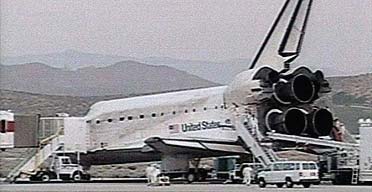The space shuttle Discovery today landed safely in California, with a mission controller saying "welcome home, friends" as its crew completed the first shuttle mission since the 2003 Columbia disaster.
Discovery broke through the Earth's atmosphere at 1,700mph and was piloted through the night sky to the ground by commander Eileen Collins, arriving exactly on schedule at 1.12pm BST.
Commander Collins landed the shuttle at 220mph on runway 22 at Edwards air force base, touching down around 53 minutes before dawn.
"Congratulations on a truly spectacular test flight," astronaut Ken Ham, at Mission Control in Houston, told the Discovery crew. "Welcome home, friends."
Commander Collins responded: "We're happy to be back in ... we congratulate the whole team for a job well done." She said the mission's success was "a wonderful moment for us to experience".
Later, in the early morning California sunshine, the crew briefly inspected the shuttle on the runway. A full news conference is expected to take place later today.
Earlier, Nasa reported no problems as the shuttle plunged through the atmosphere over the Pacific and began enduring the period of maximum heating, which takes place around 20 minutes before touchdown.
As Discovery headed towards the landing strip in the Mojave desert, radio contact between Mission Control and the shuttle was kept to a minimum.
Double sonic booms sounded over southern California as it dipped below the speed of sound for the first time since its launch two weeks ago.
Pilot Jim Kelly steered Discovery in a wide circle to burn off speed 30,000ft (9,000 metres) above the runway - a point the Columbia never reached - before Commander Collins took over and steered the shuttle onto the landing strip.
Discovery had been due to arrive at the Kennedy Space Centre in Florida three hours earlier, but stormy weather over the east coast saw flight controllers direct it to the other side of the US.
The landing had already been postponed from yesterday because of the weather conditions.
Nasa will now spend around $1m (£560,000) on returning Discovery from California to Florida, piggybacking on a Boeing 747.
The families of the astronauts will have to wait until tomorrow to see their loved ones. Their reunion in Houston was delayed after the decision to switch to the opposite coast.
Nasa's leading officials had also gathered at Cape Canaveral to welcome the crew home.
"There's nothing more that I would love to see than it here so everybody here could be a part of this. But it's not going to be," Bill Parsons, the shuttle programme manager, said. "I want it to be safe, wherever the safest place is to go."
Discovery had been following a course over the Pacific and into Southern California. Nasa officials said they would adjust the flight path so it skirted Los Angeles under new public safety considerations brought in after the Columbia disaster.
The Columbia disintegrated on re-entry to the Earth's atmosphere, killing all seven astronauts on board.
Investigators blamed the disaster on a large piece of insulating foam that broke off the tank during launch and punched a hole in the wing, allowing superheated gases to enter as the shuttle returned to Earth.
Discovery's 14-day mission has been beset with problems. Nasa grounded the shuttle fleet after a chunk of insulating foam broke off Discovery's external fuel tank during its lift-off on July 26. Unlike Columbia, Discovery narrowly missed being hit by the chunk of foam.
Then astronaut Stephen Robinson had to make the first-ever orbital repairs, gently pulling two strips of thermal tile "grout" away from the shuttle's heat shield.
Until the spacewalk to pull out the two protruding gap fillers, astronauts had never ventured beneath an orbiting shuttle or made repairs.
However, Discovery's launch and flight to the international space station could be the last for a long time.
Nasa officials said a shuttle would not fly again until the foam problem had been solved and engineers understood why the two so-called gap fillers came loose.
"It's going to be a new beginning for the space shuttle programme," Bill Readdy, Nasa's spaceflight chief, said.
"The approach that we've taken has to do with a very methodical series of flight tests. It's exactly the right approach."
Discovery spent nine days hitched to the space station, where astronauts restocked the orbiting lab and removed broken equipment and rubbish, one of the main goals of the mission.
The crew successfully carried out three spacewalks, including one to test new tools and methods for fixing a damaged shuttle heat shield in orbit.
They also tested some new flying manoeuvres, flipping the shuttle end over end near the space station so cameras could zoom in on the underside as part of the exhaustive search for damage.
